Electronic Killers / A River Hotel

|
• BreakFree Mediterranean Hotel Gold Coast • Budds Beach Apartments • Sofitel Gold Coast Hotel • Q1 Resort & Spa |
Feature Photograph

This weeks feature photograph was captured in Ayutthaya. The photograph is significant because it’s a decent example of what I spent a few hours describing to a client during a workshop which was focused on landscapes. More, its significant because this is a good example of the almost perfect type of light that lends a 3D effect to an ideal landscape. Combine the ideal elements of a landscape which includes in this case a foreground, mid-ground, and background.. illuminate it with almost perfect natural light.. and you are rewarded with colors and depth rarely seen in a natural setting.
Can you almost imagine yourself bracing the left side of your body against the brick wall to the left, taking the picture, and then walking down the path to the right of the tree and back between the brick structures? A good landscape allows you to ‘picture’ yourself being there, feel the texture of the rough bricks, hear the leaves crunch underfoot, and hear the wind rustle through the trees. A good landscape invokes more than the visual, it also invokes memories of the sounds, smells, temperature, and even the humidity in the air.
Of course a large 20×24 inch print on textured cotton art weave makes all this a lot more easy to imagine than a 410×600 pixel image on a website, but much of the process of creating art is about envisioning a concept or image.. and then making it comes to life through the artistic process.
During workshops I rarely take my own pictures. I’m there to help the client take pictures and I can’t do that if I’m involved with my own camera. In this case I was with a client who had a good understanding of the mechanics of photography so we spent a few hours at this one specific location discussing the images possible from this one small area. We’d discuss what we could see and how to use the camera to capture the scene.
During the afternoon we spent together at this location we noted the perfect natural light, the way the light was shining through the leaves in a way that made them almost translucent and saturating the natural colors of the scene. Every once in a while I’d glance over at a new perspective I hadn’t seen at this location in the almost 50 previous visits. I noted the possibility of using the brick stand as a foreground, the tree with the purple flowers as a mid-ground, and the path that led through the frame to the background. And I couldn’t help but notice that perfect light. I really wanted to pick up my own camera and capture this scene, but I was giving my attention to my client and he was taking the images. Some workers came out to rake some leaves and he went over to take pictures of them so I quickly picked up my camera, fed in the settings from experience and without metering, and snapped off 2-3 images of the above scene.

Meanwhile I was watching his technique while he captured the ladies working in the image above. I noted his bracing techniques, how he positioned himself against the direction of the light, how close/far he was from the subjects for the desired composition, and all of a sudden I realized we had the makings of another good landscape. I stepped around the far corner of the brick stand, turned to the left, and using the brick stand once more as a foreground (as well as the lady in blue), the other ladies and the tree as a mid-ground, and the tall brick structures as the background I had everything I needed but the perfect light!
The first picture above is 100% natural, the light and colors, the only processing was about ¼ of a stop less exposure. The light in the second picture being 90 degrees different from the first was flat. There was no natural 3D effect, no natural bright colors, and no shadows lending interesting dimension. Still, the compositional elements were present so I released the shutter and made the capture.

The picture above was the result. The first picture was 100% natural light. The second picture was light processed through post-processing, and the third picture (above) was how the second picture looked before being processed. Why is all this significant? Because even though we desire and go to extremes to be on location during the best natural light, we don’t always get it. When we’re traveling and sightseeing we’re on location because that’s when the tour bus stopped and let us out, or because the wife wanted to eat lunch before walking the site and not after. We’re on location for purposes other than predicting when the best light will be present and this is probably true for vast majority of the images captured while on vacation. Unless we’re going out to specifically capture a scene, good light is a matter of luck and not design.
This means that if we want to present our travel images in the best possible way, then we’ll need to learn at least minimal post-processing skills. If we expose the image correctly which we learn during the outing portion of a workshop, then we’ll have lots of latitude to post-process the image during the computer/software portion of the workshop. Can you see why I always tell my clients that with digital photography we’ll normally spend at least half our workshop on the computer and post-processing? Actually, the post processing part can be a lot of fun. You can do it weeks, months, or even years later. As your skills ground you can do it over and get better results. As software improves you have more options and capabilities. Sometimes for fun I’ll process ten year old RAW files with the latest software and compare my results from ten years ago. RAW processors just keep getting better and better.. and I suppose my post-processing skills do as well. So will yours!
Chotika River Front Hotel, Samut Songkram
Originally I went to Samut Sakhon to photograph the boat yards and while I completed that objective I was so taken with the hotel my traveling companion selected I decided to push it to the front of the queue. We’ll get to the boat yard pictures soon, promise..
Samut Sakhon is roughly 60 kilometers from Bangkok and very close to the Damnoen Saduak Floating Market I featured some weeks back. It’s halfway between Bangkok and Hua Hin, right off Rama II (Highway 35), and its full of hidden treasures including an active small town, its own floating market, and kilometers upon kilometers of klongs and rivers to explore.
The Chotika River Front Hotel appears to be built around a lumber mill. In fact, there is a lumber mill located right in the middle of the hotel area that’s still active as I can attest after being awaked by the high speed motors and screech of a large wood planer. Perhaps they had so much extra lumber sitting around unsold they decided to put it to good use and build a nice hotel? Great idea if they did!
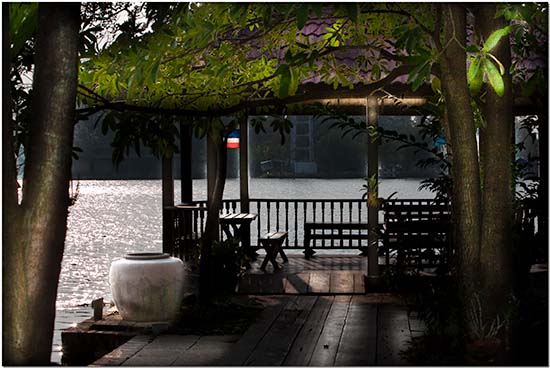
There are numerous small gazebos and porches overhanging the river. The mood set by the river, lights, natural wood.. its all very inviting and relaxing. Btw – the rates are very reasonable and run from baht 1200 to baht 3500 depending mostly on the location of the room to the view.
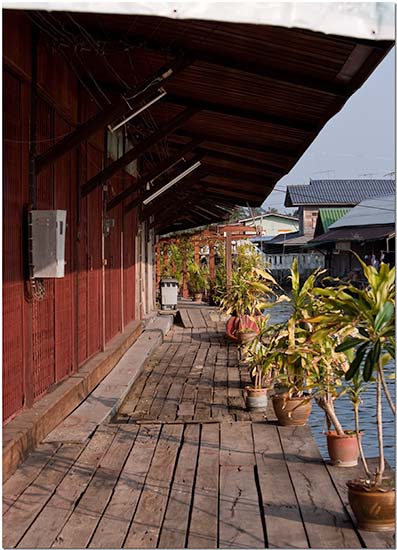
There are many wooden walkways over the river. You must walk on them to get to your room, the restaurant, and lobby.
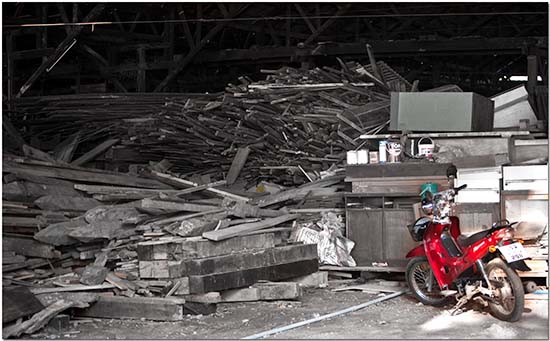
Inside the main mill area you’ll find areas both clean and organized, and like the picture above a total mess! The mill building is huge and the scent of freshly cut woods is very alluring. As a hobbyist workworker who had a shop in Oregon I’m familiar with mills and the smells of Douglas Fir, Oak, Cedar, Cotton Wood, Maple, and the rest of our local woods.. but here the teak and rosewood seems to have very little scent in comparison.
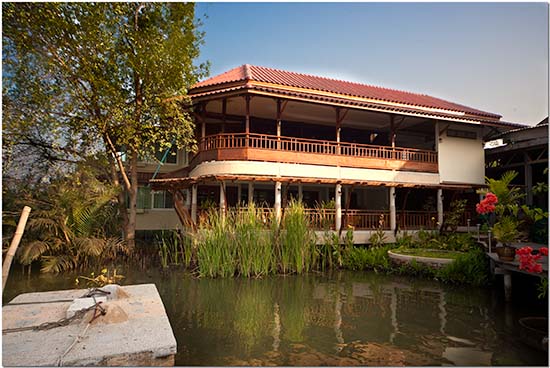
Above you can see one of the room structures where we stayed. There are two floors, the upper floor of course has a better view, but the lower floor helps you avoid the common small Thai staircases which often don’t bode well for westerners toting large bags.
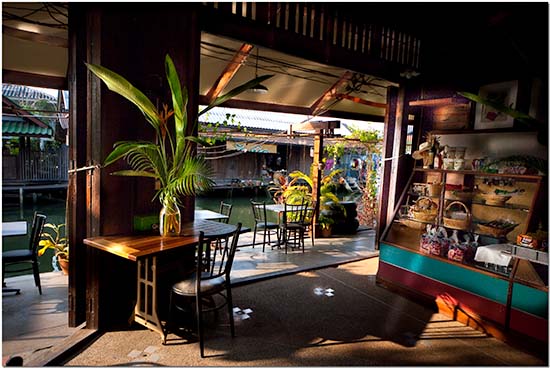
I’m more than a bit embarrassed. I was up late processing the days images and when 0600 rolled around I was still fast asleep. My traveling companion looked out the door and woke me by saying “you should see the light, it’s beautiful, come take some pictures!” I groaned and moaned and finally put the camera in Program mode and told her she could take pictures but I was going to finish this great dream I was having.
Later that evening I couldn’t believe the images she took! Being an artist herself she must have a natural eye and indeed the light was fantastic! I love her work!
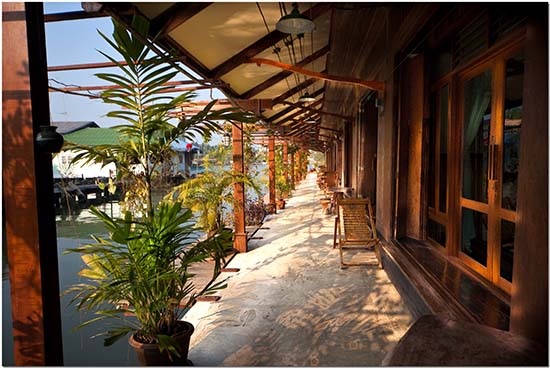
She did it again! The morning light was beautiful and gives the image a three dimensional look you couldn’t pay for. The wood really looks good when lit with soft morning light.
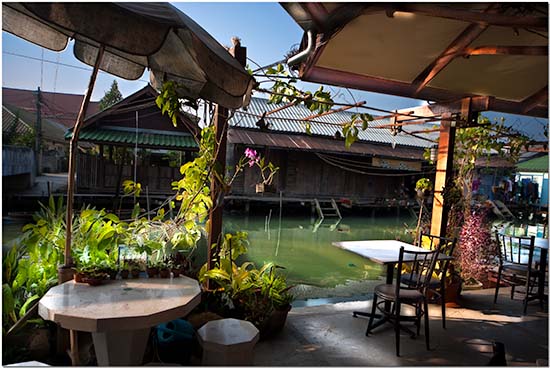
Okay, to be fair I’m showing one more of her images. This is where you can eat breakfast and watch the river life float by at the same time. Remember guys, don’t loan your camera to a woman unless you’re prepared to be humbled..
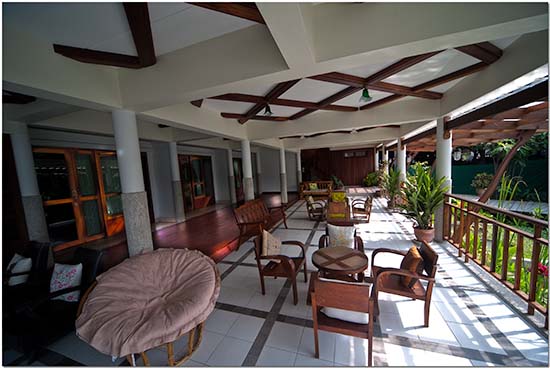
Outside our room was a lovely patio area with cushioned chairs, fans, and a wide open feeling. This was a very quiet and peaceful place from the time we arrived in the late afternoon, until about 0800 when the mill opened up.
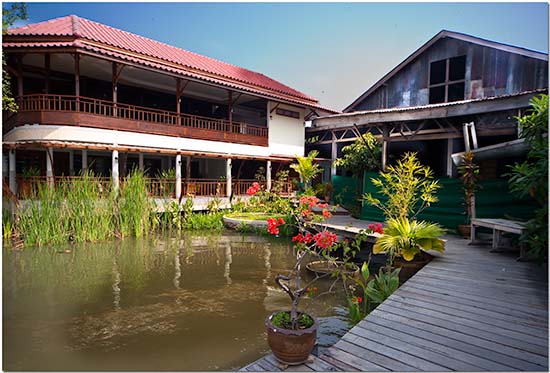
You can see how we walked to our room, along the wooden walkway, past the mill structure, and to the room structure where our room was located. This is only a very small part of the total hotel complex.
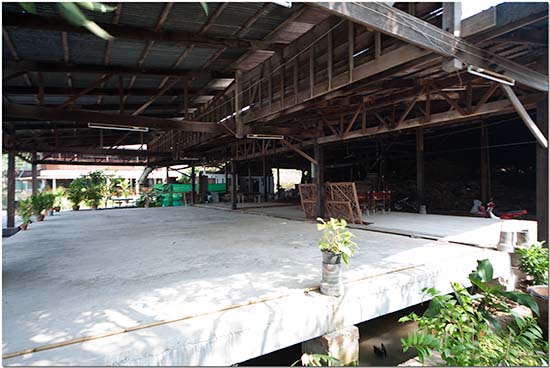
This is a big staging area for the prepared lumber. It’s located directly at the waters edge so the lumber can be loaded in the boats and taken to wherever lumber is taken these days.
This was a very different hotel experience than you normally experience in Thailand. It’s been a long time since I’ve stayed at a place so inviting, relaxing, and beautiful.. the lumber mill really made the spot because I love such places! I’ll be doing another outing just on the mill later on. If you ever want to get outside of Bangkok for a few days and experience a unique hotel and really nice people, give the Chotika River Front Hotel in Samut Songkram a try.
Electronic Killers, Heat and Power Surges
I received a fair amount of email asking about my comment that excess heat and power surges were the number 1 and 2 causes of electronics failure. This is absolutely true so I decided to use the learning topic this week to explain why and give you a more complete explanation and some examples.
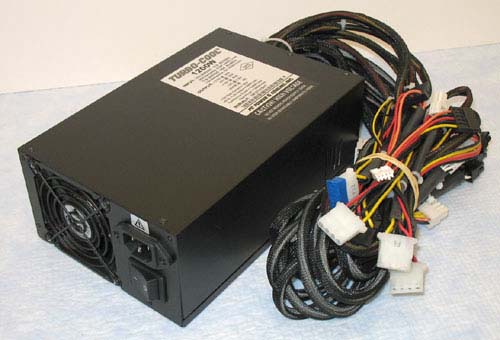
Electronic components have heat ratings. They’re designed to operate in a specific heat range and with few exceptions the hotter you run a electronic component, the less its lifespan. This can be a very significant difference. Some components like central processor units (CPU), graphic processor units (GPU), power supply regulators (all IC chip technology) are much more sensitive to heat than other components like resistors, capacitors, coils, and diodes. This is why the CPU and GPU of computers always have fans or some form of auxiliary cooling device attached.
Take my power supply that failed which I talked about in last weeks blog and this weeks blog. It was rated at 200,000 MTBF (mean time between failures). That’s over 25 years of life under normal operating temperatures on average, before it was expected to fail. It failed at 3 years. Why? Because I failed to clean the vents providing the critical air flow necessary to keep it at a reasonable temperature. With the vents blocked with several thick layers of dust air couldn’t flow per its design, the components heated up beyond their ideal temperature, and eventually the power supply failed. 22 years earlier than it should have! I’m guessing the power supply operated for at least a year at this heat before failing.
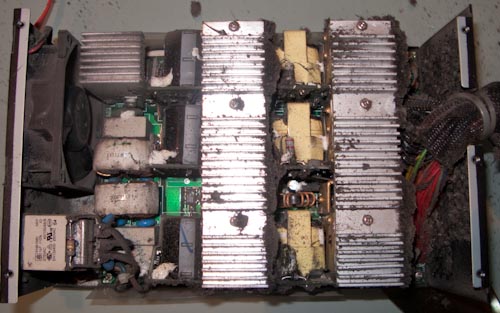
Heat is the enemy of all electronics. Remember this before covering air vents with books or other equipment, or when choosing the type and number of fans for your next computer build. Remember this and clean your air vents often. I knew this and I still got lazy and didn’t realize how badly they were blocked.
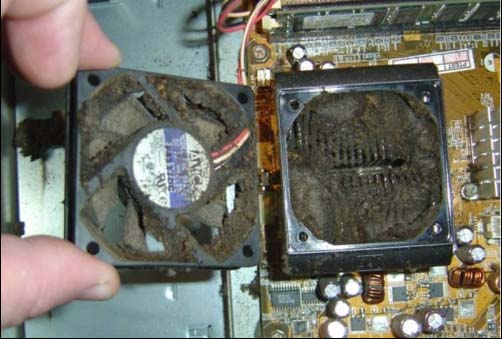
Power surges are the next most common enemy of electronics. Almost all modern electronics run on DC (direct current) power. 100% of electronics running any sort of digital processing or IC chip. However, DC power DOES NOT come out of the wall. Wall outlets provide AC (alternating current) which must be converted to DC.
Power supplies and/or power adapters convert AC to DC. The battery charger for your camera is probably run by plugging in a power adapter (small brick like device) to the AC outlet and then plugging it’s power output cord into your battery charger. The power adapter is converting AC into DC. Virtually all modern devices have these adapters. Cell phones, battery chargers, GPS’s, external hard drives, laptops, calculators, and most everything else. A desktop computer uses a bigger source called a “Power Supply” that does virtually the same thing. Your flat screen television, microwave, stereo receiver, all of these types of devices have an internal power supply that converts AC to DC.
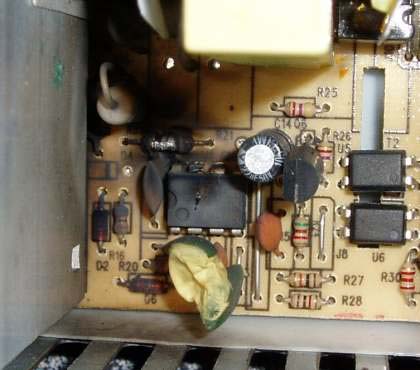
Not all power adapters and power supplies are created equal. DC (direct current) power should be very clean (free of AC ripple voltages) and the output constant, even under heavy load the output should remain clean and at a constant voltage. Cheap low power adapters are rarely an issue, but power supplies used in desktop computers, televisions, and stereo equipment are frequently an issue because they use more power and the more power you draw, the more difficult and expensive it is to provide clean and constant power.
Have you ever noticed that laptop computers tend to be more reliable and stable with less BBSOD’s (big blue screens of death) or other glitches or issues? The reason for this is simple. Laptop computers run off DC voltages (the battery) 100% of the time. The battery is providing 100% of a laptops power 100% of the time, clean and constant, from the battery. The AC adapter charges the battery, and the battery runs the laptop. The battery acts like a sort of UPS (uninterruptable power supply) which protects the laptop from power surges and ripple voltage providing a clean reliable source of DC power. A desktop by comparison uses a lot more power and that power is provided in most cases by a very cheap power supply that converts AC to DC with no battery in the middle for isolation as in the case of a laptop.
It has been my personal experience, and accepted throughout the industry, that almost any electronic item that uses IC (integrated circuit) technology will run very stable and last almost forever, if from the very start the device is run from a UPS device in the case of a computer, or a high quality surge protector in the case of stereo and televisions. For instance, most think that a desktop computer will operate correctly until it fails to operate at all. This could be, but there’s far more to it. If a desktop computer is operated without a UPS or surge protector, and is equipped with anything less than a top quality power supply, then it’s very possible AC power surges and fluctuations are causing wide enough variations in the power supplies output of DC voltages, that these variations can stress the operating range of different IC components in the computer which can/will result these components not operating correctly while the rest of the computer runs on as normal.
This sort of damage is cumulative over time and eventually you end up with a computer with enough “scars” that they’ll cause what appears to be random glitches and errors and malfunctions. Usually these aren’t random, but rather there are “scars” in RAM or other components that only get accessed during certain operations. They might appear to operate properly during one software instruction/operation, but not the next. What you end up with is a “glitchy/buggy” computer, and most will blame the computer manufacturer, Windows, Leopard, viruses, malware, or anything but the real cause.. which is operating a relatively delicate computer without a UPS, surge protector, or top quality power supply. Ideally you’ll have a UPS with a built in surge protector and a top quality power supply. At the minimum you should have one or the other. Please know, you cannot run without a UPS or top quality power supply, start experiencing errors/glitches, and then add a top quality power supply and UPS. The damage is done and the defective parts of the computer must be replaced to guarantee stability.
The problem is, these sort of problems are most often impossible to pinpoint and even more impossible to get warranty replacements for components that appear to be working. Power “scars” have been the cause of more headaches for electronics technicians than any other cause. Even the best technicians will spend 10-20x more time troubleshooting, spraying components with “instant freeze” and then a heat gun, and whatever else helps them track down these sorts of issues. The military, major corporations, and factory repair centers have learned long ago it is much more ‘cost affective’ to replace entire assemblies or circuit boards, then it is to trace these types of issues. It is far better to avoid the ‘scars’ by using a UPS and top quality power supply.
Cheaper power supplies for all kinds of electronic equipment such as desktop computers, televisions, stereos, etc, provide a much less ‘clean’ DC voltage, often having much higher amounts of AC ripple voltage. Also, you probably realize that AC power from your AC outlets provided by the power company surges regularly. If you’re supposed to be getting 240vac, you’re constantly getting voltages above and below that, something like 200-280vac’s and even worse ranges during periods of high power uses (hot days, busy times of day, etc) Power supplies are designed to provide their DC output voltages for a pre-determined range of AC power with a specified amount of AC ripple voltage. The higher the quality of the power supply, the more range of AC power it can accept and still provide the required DC voltages, and the higher the quality of the power supply the cleaner the DC voltages (less AC ripple) which means your electronic equipment lasts MUCH longer. Not only will your electronic equipment last longer, but it will run more reliably and with less power induced malfunctions.
Even cheap power supplies tend to provide a decent DC voltage at moderate loads. Put the equipment under load however and those DC voltages start fluctuating greatly and ripple voltage increases sharply.
Now you know why a 500watt desktop computer power supply can cost as little as $10 USD’s, or as much as $350 USD’s. A high quality power supply provides more constant and clean DC voltages while accepting a wider range of input AC voltages, and it maintains this high quality DC voltage from idle to maximum rated load.
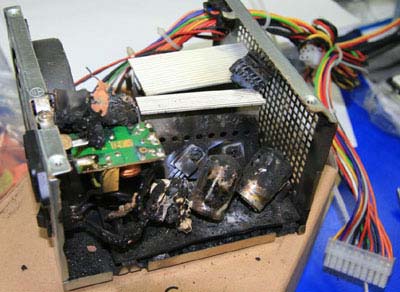
There is nothing better you can do for your desktop computer than ensure it’s equipped with a high quality power supply that provides the required load. Once you’ve done this, the next step would be to place a UPS (uninterruptable power supply) such as one from APC (American Power Conversion) between the AC wall outlet and your computers power supply.
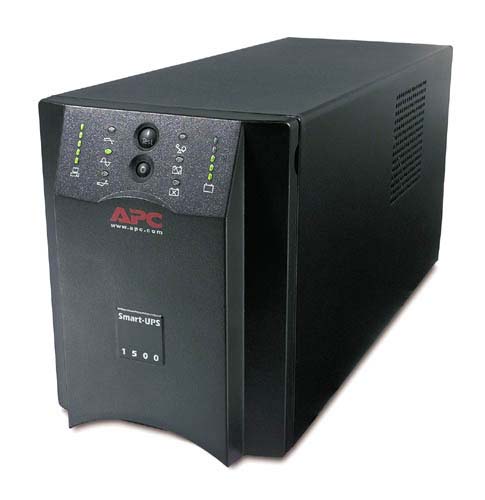
Have you ever noticed that high quality power supplies are bigger and much heavier than cheap ones? For instance, that a DVD or CD player can be heavy or feather light? That a stereo receiver or tape player can also be very light in weight, or very heavy? Most of these differences in weight are due to them being equipped with high quality power supplies. The components that allow for constant and clean voltages are physically bigger and heavier than lesser components. Other weight differences in such equipment will be traced to heavier electric motors, heavier transport systems equipped with ball bearings vs. limited life bushings, and so forth.
Electronic manufacturers have long figured out that the average consumer won’t be using their equipment for many total hours before replacing it was a new model, so they often make “disposable” electronics which are sold very cheaply, and then “enthusiast” or “professional” electronics which they know the consumer will use much more and keep longer.
To summarize, the best thing(s) you can do for your electronic equipment, computers, chargers, stereos, televisions, etc.. is keep them as cool as possible, and if you have the option of selecting it’s power supply then select a high quality power supply. Use a UPS (uninterruptable power supply) for all devices with IC chips (laptops, computers, etc) and for as many of your other devices as feasible.
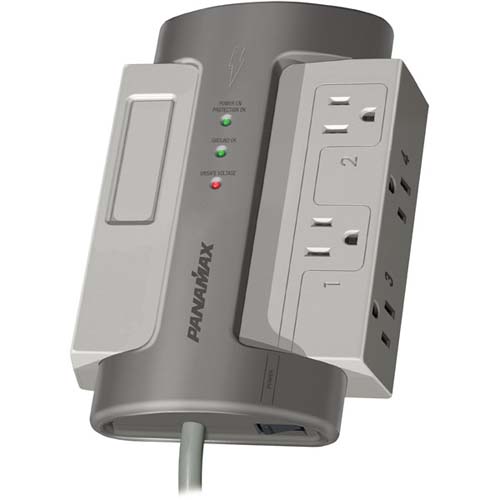
How this relates to your digital camera: A DSLR’s image sensor is only “powered up” when the shutter is open, or during live view. The more warm/hot a image sensor becomes, the more noise they produce, and the less their life expectancy. This is why for years DSLRs automatically turn on noise reduction during long exposures. This is why exposures lasting for more than 20-30 seconds seriously drain batteries and why noise reduction is always turned on. Most photographers don’t use long exposures often enough to reduce the life of their image sensors (DSLRs) but all this is changing with LIVE VIEW. Live view will be used more often and for longer periods of time. Remember, the hotter your image sensor becomes the more noise it produces. If you were using “live view” to view/compose your scene for a few minutes then the sensor is hot, and it recording more noise.
But what about movie modes? Yes, recording movies with your DSLR seriously heats up your image sensor and drains your batteries very quickly. The prototype of the Canon 5d Mark II allowed the DSLR to record movies up to 30 minutes in length. By the time the production version was released Canon had limited this to five minutes after learning the heat was prematurely destroying the cameras expensive sensor and inducing huge amounts of noise.
My final advice? Be cool and be steady. Don’t skimp when it comes to power. You get what you pay for when it comes to cooling systems and power supplies.
Photography News of Interest
The 24-70mm F2.8 zoom is a very popular mid-range zoom and every DSLR manufacturer makes one. The problem for hobbyist especially is these lenses can be very expensive, often from $1200-$1500 USD. The generic brand lenses (Sigma, Tamron, etc) have always been cheaper, but have usually been missing either the high speed focusing motor, the F2.8 aperture, or are just a poor overall quality. Now, Sigma is shipping their new 24-70mm F2.8 EX DG HSM lens that looks to solve all these issues and at a price point of roughly half of the OEM’s!!! This is great news, especially if the lens performs. I’ll be watching for a review on this lens and will post it here. This lens will be available for Canon, Nikon, Pentax, Sony and all popular mounts. You can read about it here.
A very interesting article over at the Luminous Landscape compares the Sony A-900, Nikon D3x, and Canon 5d Mark II for noise. These are the major three high-resolution offerings from the big three. You can read the test and see the test images and evaluations here.
Another group test of cameras has been posted over on Digital Photography Review and this time it’s comparing the “SLR-like” ‘super zooms’. These cameras are a lot of fun and pack a lot of capability into a small camera at a relatively inexpensive price point. They excel at providing a small body with a huge zoom range, and not a whole lot more. Read the Group Test and perhaps you’ll see a model that will fit your travel style. Read the test here.
Travel cameras should be as small and light as possible while providing the most image quality possible. Unfortunately we haven’t had many choices, or a quality choice at all. A new camera I mentioned a few months ago that fits this use perfectly is the new Panasonic Lumix G1. It’s the worlds smallest DSLR using the new “micro-4/3’s” system. The Digital Outback does very complete quality reviews which can be very helpful to a prospective buyer. They’ve started a review diary on the G1 and will be adding to is as they use the camera. You can keep track of it here.
Can you envision a small Secure Digital (SD) card that not only stores your data, but on command can send your images and/or video to Utube or your own FTP server via Wi-Fi automatically? A wireless SD card! Very cool if you need the capability. You can read about it here.
Readers Submissions
Sorry, but there were no readers submissions for this week.
I suspect the readers submissions will be a highly anticipated section of this column and I encourage anyone with photographs and travel accounts they d like to share to please send them to me at: QandA@Bkkimages.com
Readers Questions
BKKSteve;
I will be looking to buy a new LCD monitor for my computer soon and to retire my old CRT. I do some Photoshop and would like monitor that can handle images. Also, how accurate is the color on the new LCD’s, will I need a color meter?
Great Weekly btw. I learn a lot reading some of the topics and I enjoy the pictures..
Sean:
Sean –
This can be a very complicated subject. Much would depend on your budget. LCD’s which are ideal for image processing are not those which are necessarily ideal for gaming or office work. The problem is gaming and office work is a lot more popular than image processing and most monitors are made for these purposes as well as a the lowest price. It would be easier to tell you what not to get, which should narrow down your choices considerably.
Do not get a TFT LCD or a TN LCD or a PVA LCD. Others to not get are the MVA and CPA but these are less common. What you want is an IPS or S-IPS LCD panel that handles the widest color gamut possible.
Contrast Ratios are heavily marketed, telling the consumer that the higher the ratio the better the monitor. This might be true for HDTV’s, but for image processing it doesn’t really matter. Even the lowest contrast ratios will be great.
So.. look for the biggest screen area in an S-IPS LCD you can afford, find it’s reviews, and read carefully. Keep in mind that most reviews on computer sites are geared towards gamers so disregard those and read the reviews on imaging sites which are far fewer.
Personally I’ve been using Viewsonic VP211b’s (5 of them) for years now. These were over $2000 USD when they first came out, and only $699 by the time they were discontinued. These are great monitors and I wish I could find more. I’ll keep using them and repairing them until I can no longer get away with it.
If I was looking for a reasonably priced image monitor today.. I’d look at the Viewsonic VP series in the size I desired. The VP2130b (21.5”) or the VP24xx series. The VP2130b replaces the VP211b’s which I love, but I have no personal experience with this monitor so check it out carefully. I’d also check into Samsungs 214T. These are all S-IPS monitors. Eizo and NEC both make high-end image monitors but at over $2000 each for the best ones they’re more than most are willing to spend. If you have the money they’re great monitors, especially the Eizo’s.
I’d also love to have a couple 30” monitors. Several companies make these now, Apple, Samsung, Dell, and others. Unfortunately I haven’t seen or read a review on a 30” monitor that would lead me to believe they’re acceptable for image processing. The colors and luminance vary far too much from center to the corners. I’m afraid if they ever do make an acceptable 30” LCD panel the price would be far more than I’d be willing to pay.
Can you see why I’m nursing along my collection of VP211b’s?
Yes, you will need to use color profiling software and a colorimeter if you want your monitor profiled. And yes, you want your monitor profiled. Why? For hobbyist this ensures that the colors you see on your LCD when post-processing your images will be the same color that your local printers have their machines set up to deliver. You wouldn’t believe how many people have told me how bad their local print shops are then when I asked if they’d profiled their monitors they didn’t know what I was asking. Most commercial printers are using Fuji Frontier printers or Kodak machines and they’re adjusted to deliver the industry standard colors. You must color profile your monitor (this includes laptops) if you want what you see on your screen to match these industry standards.
For advanced hobbyists and professionals there’s a lot more reasons to color profile your monitors. There’s also a lot of hardware requirements and discussion, printer profiles, and much more. I can help you do all this during a full day’s workshop, but only to a basic professional level. The best guys who do this stuff use thousands of dollars worth of equipment and charge over $1000 a day to work with you building profiles and setting up your monitors, printers and scanners to all work together and see the same colors.
During a normal workshop that includes post-processing I encourage the client to bring their personal laptops with them and I color profile their monitors for them as a courtesy so they can see the difference when hitting the “before/after” key. This takes about 10-15 minutes. This also ensures the colors they’re seeing on their monitors are the same colors their local printers have their machines set to. This is all most people need.
I hope all this helps. I’ll be covering this topic more in-depth in the future in a learning topic.
Steve
Please submit your questions to QandA@Bkkimages.com All questions will be answered and most will show up in the weekly column.
A Snapshot of Bangkok Images Week in Review
This was a busy week, it appears the season is picking up. We had one workshop where we took what I call the “Pattaya Loop” which includes a one day outing where we visit the Tiger Zoo, Open Zoo, and the Sanctuary of Truth. Three great places, lots of great images, and plenty of time to learn new techniques. We can back at the end of a busy day and spent hours going over post-processing techniques.
Today the loop was a bit different. The special tiger pen at Siracha Tiger Zoo is now sporting a series of 3 rows of black thick bars about 12-14 inches apart, obviously put there in case a tiger decides to try and jump out and eat an annoying visitor. These bars totally spoil a very unique location, the only location I know of that allows the photographing of running and playing tigers through water and ponds WITHOUT a fence or glass partition between you and the tiger(s). You can still shoot across to the elevated cubby holes where they take naps, but not below where they play, run, roar, and slap each other around. I know of no other place that offers anything close to what we had before the bars. I wonder what prompted them to place the bars? I can see at least a dozen more necessary projects just from the entrance to the tiger pen. Perhaps one of the tigers really did jump up and become too friendly with a visitor.
I had a great time on this workshop, yet another workshop that started before 0900 and didn’t finish until right before midnight. We returned from the ‘loop’ at about 7pm, ordered a pizza, and worked on post-processing until we could no longer keep our eyes open.
This week we also met with an agency visiting from Malaysia who might be interesting in signing our workshops. I hope this works out.
More computer repairs have been completed and we’re mostly back up on-line, but we’re not yet at 100%. We will be by this time next week, I hope.
Infocus Blog
Quieter, cooler, and better looking than ever..
Last week I blogged about my IT equipment woes and shared some pictures of the patient being operated on while laid out on the dining room table. I received several concerned emails so let me say up front that no computers were hurt or lost their life during the filming/photography of the autopsy. Fake computer doubles were used for all scenes showing an excess of body fluids and where all pain would be involved.
Once the patients parts were cleaned and inspected it was determined the only part that needed to be replaced was the power supply. While we were inside we opted to remove the water cooling system and replace it with a new modern air cooling tower with a 120mm fan. We also went ahead and replaced all the 120mm fines with variable speed long life models designed for quiet operation..

The power supply was covered under warranty (despite being obviously abused by the blocked air flow), but because of non-specific RMA (return merchandise authorization) policies the Thailand division opted out of the replacement forcing me to send it off to the states for replacement which could take more than 3-4 weeks. I bought a new one to use now, and the old one when replaced will be used to build a new Intel I7 core (8 cores) machine later this year.
The new power supply is only a 750watt model (100,000 MTBF) vs. the old server class 1000watt model (200,000 MTBF). After building the system the first time I noticed the actual wattage draw from the UPS to be only 380watts. This was a quad core processor, 4gigs of RAM, 12 SATA hard drives, and two high power graphics cards as well as DVD drives and other parts. The 1000watt power supply was overkill, so the 750 watt model will work out nicely. It’s also a much quieter model. 100,000 MTBF (mean time between failures) gives it a life of roughly 12 years which is way beyond how long I plan on keeping this machine and the next.

Now that the workstation is air-cooled with the new high-end cooling tower and quality fans it is much quieter and cooler than ever! The CPU ran at 50-55c with the water cooling and now runs at 36-44c with the new air cooling. 36c at idle (6c above ambient temps) and 44c with all fore cores under load at 90%+ for an extended time. The new lower temps allow the fans to be run at only 20% of their speed at idle and 40% under load resulting in much quieter operation. The new power supply is whisper quiet at idle, and barely audible under load. I could still use a replacement battery for my server class UPS if anyone knows where they sell such things? This is two 12vdc batteries strapped together to make a 24vdc heavy duty core.

Most gamers use water cooling or expensive air cooling towers like these so they can run their computers at higher clocking frequencies thereby increasing performance. Good for them. I use water cooling or air cooling towers at normal clock speeds to extend the life of the machine, increase its reliability, and to achieve the most quiet operation possible. The workstation is now as quiet as a noisy laptop.. which means when placed on the floor out of the way you can hardly hear anything at all. Wonderful!
Now that the workstation is running perfectly I’ll continue to use it and will make it my secondary workstation later this coming spring when I build a new workstation. We have a lot of choices when we design and build our own systems, choices which should result in not only a faster and cheaper workstation, but also a workstation better suited to your individual needs and workflow. You get to make choices like less noise over more speed, or a bigger case which can hold more drives for a bigger RAID array, or a workstation which can hold four graphics cards that provides four LUT’s that will allow for four individual color profiled monitors. Whatever you need and/or desire can be easily and in most cases cheaply built with minimal effort.
Until next time..



